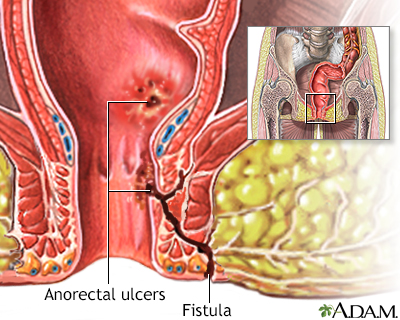Fistula
A fistula is an abnormal connection between two body parts, such as an organ or blood vessel and another structure. Fistulas are usually the result of an injury or surgery. Infection or inflammation can also cause a fistula to form.
Information
Fistulas may occur in many parts of the body. They can form between:
- An artery and vein (arteriovenous fistula)
- Bile ducts and the surface of the skin (from gallbladder surgery)
Bile
Bile is a fluid that is made and released by the liver and stored in the gallbladder. Bile helps with digestion. It breaks down fats into fatty acid...
 ImageRead Article Now Book Mark Article
ImageRead Article Now Book Mark Article - The cervix and vagina
Cervix
The cervix is the lower end of the womb (uterus). It is at the top of the vagina. It is about 2. 5 to 3. 5 centimeters (1 to 1. 3 inches) long. Th...
 ImageRead Article Now Book Mark Article
ImageRead Article Now Book Mark Article - The neck and throat
- The space inside the skull and nasal sinus
- The bowel and vagina
- The colon or intestine and surface of the body, causing feces to exit through an opening other than the anus (enterocutaneous fistula)
- The stomach and surface of the skin
- The uterus and peritoneal cavity (the space between the walls of the abdomen and internal organs)
- An artery and vein in the lungs (results in blood not picking up enough oxygen in the lungs)
- The navel and gastrointestinal tract
Crohn disease can lead to fistulas between one loop of intestine and another. Injury can cause fistulas to form between arteries and veins.
Types of fistulas include:
- Blind (open on one end only, but connects to two structures)
- Complete (has openings both outside and inside the body)
- Horseshoe (connects the anus to the surface of the skin after going around the rectum)
- Incomplete (a tube from an internal structure that is closed on the other end and does not connect to skin)
Reviewed By
Linda J. Vorvick, MD, Clinical Professor, Department of Family Medicine, UW Medicine, School of Medicine, University of Washington, Seattle, WA. Also reviewed by David C. Dugdale, MD, Medical Director, Brenda Conaway, Editorial Director, and the A.D.A.M. Editorial team. Editorial update 11/27/2024.
de Prisco G, Celinski S, Spak CW. Abdominal abscesses and gastrointestinal fistulas. In: Feldman M, Friedman LS, Brandt LJ, eds. Sleisenger & Fordtran's Gastrointestinal and Liver Disease. 11th ed. Philadelphia, PA: Elsevier; 2021:chap 29.
Lentz GM, Fialkow M. Anal incontinence: diagnosis and management. In: Gershenson DM, Lentz GM, Valea FA, Lobo RA, eds. Comprehensive Gynecology. 8th ed. Philadelphia, PA: Elsevier;2022:chap 22.
Taber's Cyclopedic Medical Dictionary. 24th ed. Philadelphia, PA: F.A. Davis Company; 2021. www.tabers.com/tabersonline/view/Tabers-Dictionary/759338/all/fistula. Accessed October 19, 2023.


 All rights reserved.
All rights reserved.